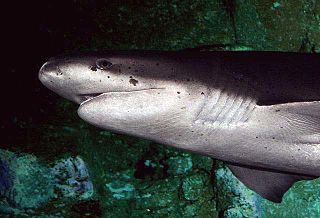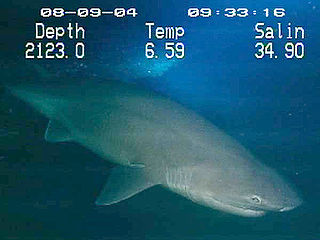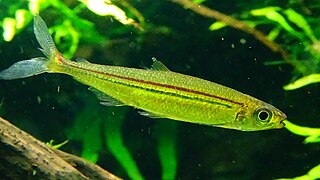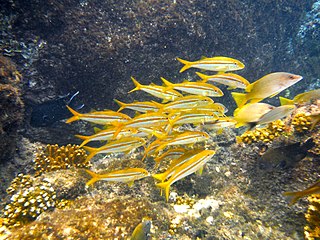
Flounders are a group of flatfish species. They are demersal fish, found at the bottom of oceans around the world; some species will also enter estuaries.

The Hexanchiformes are a primitive order of sharks, numbering just seven extant species in two families. Fossil sharks that were apparently very similar to modern sevengill species are known from Jurassic specimens.

Cow sharks are a shark family, the Hexanchidae, characterized by an additional pair or pairs of gill slits. Its 37 species are placed within the 10 genera: Gladioserratus, Heptranchias, Hexanchus, Notidanodon, Notorynchus, Pachyhexanchus, Paraheptranchias, Pseudonotidanus, Welcommia, and Weltonia.

Diplomystus is an extinct genus of freshwater and marine clupeomorph fish distantly related to modern-day extant herrings, anchovies, and sardines. It is known from the United States, China, and Lebanon from the Late Cretaceous to the middle Eocene. Many other clupeomorph species from around the world were also formerly placed in the genus, due to it being a former wastebasket taxon. It was among the last surviving members of the formerly-diverse order Ellimmichthyiformes, with only its close relative Guiclupea living for longer.

The summer flounder or fluke is a marine flatfish that is found in the Atlantic Ocean off the East Coast of the United States and Canada. It is especially abundant in waters from North Carolina to Massachusetts.

Lutjanidae or snappers are a family of perciform fish, mainly marine, but with some members inhabiting estuaries, feeding in fresh water. The family includes about 113 species. Some are important food fish. One of the best known is the red snapper.
Chongichthys is an extinct genus of marine ray-finned fish that lived during the Oxfordian stage of the Late Jurassic epoch. It contains one species, C. dentatus from the Quebrada El Profeta of Chile. It is named after Chilean geologist Guillermo Chong.

Piabucus is a genus of freshwater tetras in the family Iguanodectidae. All three species are found in South America, largely the Amazon and its major tributaries. None of them are longer than half a foot long, with the largest reaching a maximum size of 12.9 cm (5.1 in), and they are slender, with relatively deep chests and long pectoral fins. Their scales are pale or silvery, with lateral lines that stand out.
Japonolaeops dentatus is a species of lefteye flounder found in the western Pacific Ocean from southern Japan to Taiwan. This is a deep water species found at depths of from 300 to 500 metres. This species grows to a length of 20 centimetres (7.9 in) SL. This species is important commercially. This species is the only known member of its genus.
The mottled false moray, is an eel in the family Chlopsidae. It was described by Alvin Seale in 1917, originally under the genus Garmanichthys. It is a tropical, marine eel which is known from the west coast of Africa, as well as regions in the eastern and western Atlantic, western Pacific, and western Indian Oceans. It typically dwells at a depth of 64–355 m. Males can reach a maximum total length of 19.9 cm.
The shortsnout conger, also known as the thicklip conger, is an eel in the family Congridae. It was described by Samuel Garman in 1899, originally under the genus Atopichthys. It is a tropical, marine eel which is known from the eastern central Pacific Ocean, including Colombia, Costa Rica, Ecuador, El Salvador, Guatemala, Honduras, Mexico, Nicaragua, and Panama. It leads a reclusive, benthic, burrowing lifestyle, and typically dwells at a depth range of 27–2198 metres. Males can reach a maximum total length of 30 centimetres.

Diplecogaster bimaculata, the two-spotted clingfish, is a species of fish in the family Gobiesocidae found in Black Sea, Mediterranean Sea and Atlantic Ocean where it is found on rocks and among seagrass or shell beds.

Apletodon dentatus, the small-headed clingfish, is a species of clingfish from the family Gobiesocidae. It is a benthic fish of shallow, rocky water on the coasts of the eastern Atlantic Ocean and the western Mediterranean Sea.

Apsilus dentatus, the black snapper, is a species of marine ray-finned fish, a snapper belonging to the family Lutjanidae. It is found in the western Atlantic Ocean.

The African brown snapper is a species of marine ray-finned fish, a snapper belonging to the family Lutjanidae. It is native to the eastern Atlantic Ocean off the coast of West Africa.

Iguanodectidae is a family of freshwater fish in the order Characiformes that lives in South America. It is home to the subfamily Iguanodectinae and the monotypic Bryconops clade. Several species in the family, such as the green line lizard tetra, the tailspot tetra, and the orangefin tetra, are sometimes taken as aquarium fish.

Iguanodectinae is a subfamily of small freshwater fish in the family Iguanodectidae. They are most prominently found in the Amazon river basin and its major tributaries, but they are also known from the Tocantins, Orinoco, and Paraguay rivers. It has two genera, Piabucus and Iguanodectes. Some species in the subfamily are taken from the wild for aquariums, like the red- and green-line lizard tetras. There is minor, but ongoing, debate regarding its taxonomy.
Piabucus dentatus, also called the chin tetra or the coastal piabucus, is a small freshwater fish from the rivers of South America. It has a wide range that includes multiple coastal drainage systems, and was once mistakenly cited from Peru. Preferred habitats are generally high in silt content and are slow-moving, including floodplain streams and estuaries.

Oxuderces dentatus, is a species of goby found in the Indo-West Pacific from India to Vietnam, Macau, China, Malaysia and Indonesia.

Mulloidichthys dentatus, the Mexican goatfish, is a species of goatfish native to the Pacific Ocean.














